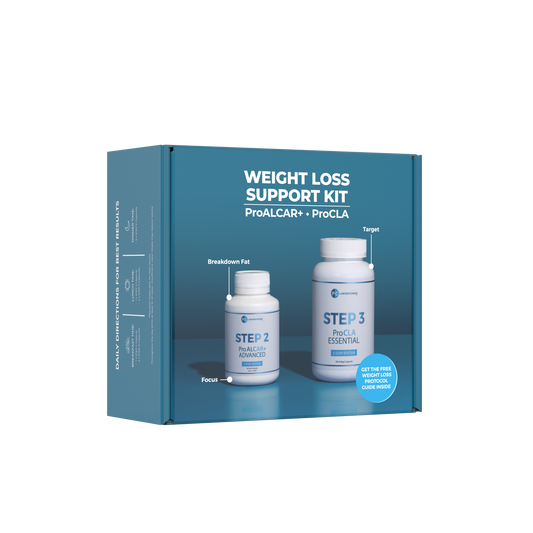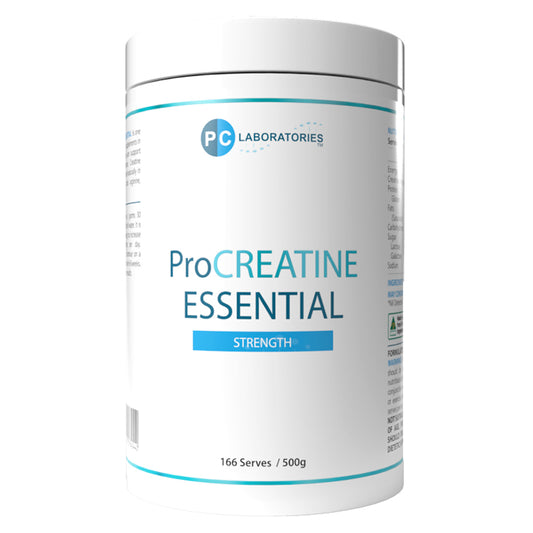Feeling hungry and tired may not just be modern life; it could be that your blood sugar is out of balance. If so, you’re not alone, as approximately one in six Australians over the age of 25 is estimated to have prediabetes. This means they have impaired glucose tolerance or impaired fasting glucose, a not-so-healthy place to be.
Perhaps you're just looking to reduce cravings, maintain energy throughout the day, rather than prevent chronic conditions like type 2 diabetes. Understanding your blood sugar is a powerful place to start, and we’re here to break it all down for you. The facts about blood sugar could help you to eat less and shed a few unwanted kilos in the process.
What Is Blood Sugar—and Why Does It Matter?
Blood sugar (or blood glucose) is the main source of energy for your cells. When you eat, carbohydrates are broken down into glucose, which enters your bloodstream. Your pancreas then releases insulin, a hormone that helps shuttle that glucose into your cells to be used as fuel.
When this process works well, your energy stays steady, and your cravings remain in check. But when it’s out of balance (too high or too low), you feel it. You may get brain fog, flagging energy or even dizziness. The good news is that you can do something about it.
The Highs and Lows: Blood Sugar Dysregulation
If you’ve ever felt jittery, shaky or hangry from not eating, that could be hypoglycemia (low blood sugar). It can happen if you skip meals, over-exercise without proper fuel, or eat high-sugar foods (hello carb coma) that cause a crash. Symptoms include:
- Fatigue
- Sweating
- Brain fog
- Irritability
- Hunger shortly after eating
On the other hand, hyperglycemia (high blood sugar) can make you feel:
- Thirsty
- Tired
- Bloated
- Moody
- Headachy
Left unmanaged, frequent spikes in blood sugar can lead to something called reactive hypoglycemia, where your blood sugar crashes rapidly after it spikes, triggering those infamous cravings and mood swings. This is more commonplace with insulin resistance, where the cells don’t take in insulin well.
How Did My Blood Sugar Get Here?
Many modern lifestyle factors contribute to dysregulated blood sugar, such as:
> Highly processed foods (especially sugar and refined carbs)
> Sedentary lifestyles
> Chronic stress
> Poor sleep
Stress is a big one. When we’re stressed, our bodies release cortisol, a hormone that signals the liver to release glucose into the blood for quick energy. If stress is ongoing, this constant glucose release can contribute to insulin resistance.
Insulin Resistance & Type 2 Diabetes
Insulin resistance happens when your cells stop responding well to insulin, and your body needs more and more of it to keep blood sugar levels in check. This can dysregulate pancreatic function and lead to type 2 diabetes, a condition marked by chronically high blood sugar.
Type 1 diabetes is different, as it’s an autoimmune condition usually diagnosed in childhood, and not linked to lifestyle. The happy news? Type 2 diabetes is largely preventable and reversible with changes in nutrition, movement, stress, and sleep.
Lifestyle Tips to Boost Metabolism
The key with blood sugar management is that small, sustainable changes can go a long way. Here’s what the science suggests:
1. Walk Daily and After Meals
Just 10–15 minutes of walking after eating can significantly reduce blood sugar spikes. Movement helps muscles absorb glucose more efficiently, even without insulin.
2. Time Your Meals
Eating at regular intervals (every 3–4 hours) can help stabilise blood sugar and prevent extreme hunger that leads to overeating. Avoid skipping breakfast; studies show it may improve insulin sensitivity.
3. Hydrate Properly
Dehydration can increase blood sugar by reducing your body's ability to clear out excess glucose via urine. Aim for around 3-5 litres of water daily, depending on your activity and climate.
4. Manage Stress
Yoga, breathwork, meditation, and even laughing with friends reduce cortisol and support better insulin response.
5. Get Enough Sleep
Poor sleep is directly linked to insulin resistance and increased hunger hormones like ghrelin. Aim for 7–9 hours of quality sleep per night.
5 Foods That Help Balance Blood Sugar
Eating the right foods can make a big difference, reducing hunger cravings and blood sugar swings. Try incorporating more of these:
1. Protein (e.g., eggs, chicken, tofu)
Protein slows down the digestion of carbs and keeps blood sugar stable.
2. Cinnamon
This common spice improves insulin sensitivity and reduces fasting glucose.
3. Chromium-rich foods (like broccoli, grape juice, buckwheat and turkey)
Chromium is essential for glucose metabolism and insulin efficiency.
4. Fibre (especially soluble fibre from oats, legumes, chia seeds)
Fibre slows the absorption of sugar into the bloodstream.
5. Non-starchy vegetables (like leafy greens, zucchini, and cauliflower)
Low in carbs and high in fibre, these fill you up without spiking glucose.
Supplements That Work
Supplements won’t replace diet and lifestyle changes, but they can help you get to your goals faster.
1. Collagen Protein Powder
A great low-carb way to add protein to meals and snacks. Collagen helps with satiety and glucose regulation. ProBurn Protein contains premium bovine collagen and tastes delicious.
2. L-Carnitine
This is our weight loss go-to, with plenty of evidence. It supports fatty acid metabolism and insulin sensitivity, especially in people with type 2 diabetes. We have ProALCAR before breakfast and lunch for better energy daily.
3. Green Tea Extract (EGCG)
Packed with antioxidants, it can help improve glucose tolerance and reduce insulin levels. ProBurn has green tea extract and collagen for some extra metabolism joy.
4. Gymnema Sylvestre
This herb has been shown to lower sugar absorption in the intestines and improve insulin function.
5. Vitamin B6 (Pyridoxine)
Important for glucose metabolism and shown to improve glucose tolerance in people with gestational diabetes and metabolic syndrome. Step 1 contains pyridoxine to help bust those cravings.
The Bottom Line
Balancing your blood sugar is important for everyone, and it is about working with your body, not against it. Prioritise real food, staying active, managing your stress, and tuning into your body’s signals. It’s the key to better energy and control of your cravings. The bigger picture is you’re ensuring long-term metabolic health, too.
References
Amini, H., Aminorroaya, A., Feizi, A., & Iraj, B. (2016). The effect of pyridoxine (vitamin B6) supplementation on glucose tolerance in gestational diabetes: A randomised double-blind placebo-controlled clinical trial. Clinical Nutrition, 35(3), 648–652. https://doi.org/10.1016/j.clnu.2015.05.012
Baskaran, K., Ahamath, B. K., Shanmugasundaram, K. R., & Shanmugasundaram, E. R. (1990). Antidiabetic effect of a leaf extract from Gymnema sylvestre in non-insulin-dependent diabetes mellitus patients. Journal of Ethnopharmacology, 30(3), 295–305. https://doi.org/10.1016/0378-8741(90)90104-8
Colberg, S. R., et al. (2016). Physical activity/exercise and diabetes: A position statement of the American Diabetes Association. Diabetes Care, 39(11), 2065–2079. https://doi.org/10.2337/dc16-1728
Derosa, G., et al. (2011). Effects of acetyl-L-carnitine on insulin resistance in patients with type 2 diabetes mellitus. Drugs R D, 11(1), 23–31. https://doi.org/10.2165/11586270-000000000-00000
Jakubowicz, D., et al. (2013). High-energy breakfast enhances weight loss. Obesity, 21(12), 2504–2512. https://doi.org/10.1002/oby.20460
Khan, A., Safdar, M., Khan, M. M. A., Khattak, K. N., & Anderson, R. A. (2003). Cinnamon improves glucose and lipids in people with type 2 diabetes. Diabetes Care, 26(12), 3215–3218. https://doi.org/10.2337/diacare.26.12.3215
Leidy, H. J., et al. (2015). The role of protein in weight loss and maintenance. The American Journal of Clinical Nutrition, 101(6), 1320S–1329S. https://doi.org/10.3945/ajcn.114.084038
Thind, H., et al. (2021). Mind–body practices and diabetes management: A review. Journal of Diabetes & Metabolic Disorders, 20(2), 1561–1571. https://doi.org/10.1007/s40200-021-00868-0
Venables, M. C., et al. (2008). Green tea extract ingestion, fat oxidation, and glucose tolerance in healthy humans. The American Journal of Clinical Nutrition, 87(3), 778–784. https://doi.org/10.1093/ajcn/87.3.778
Vincent, J. B. (2000). The biochemistry of chromium. The Journal of Nutrition, 130(4), 715–718. https://doi.org/10.1093/jn/130.4.715
Weickert, M. O., & Pfeiffer, A. F. H. (2008). Metabolic effects of dietary fibre consumption and prevention of diabetes. The Journal of Nutrition, 138(3), 439–442. https://doi.org/10.1093/jn/138.3.439
Zdzieblik, D., et al. (2021). Collagen supplementation and markers of glycemic control: A review. Nutrients, 13(2), 509. https://doi.org/10.3390/nu13020509








